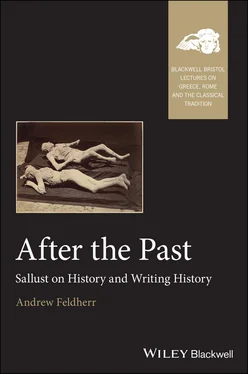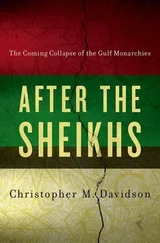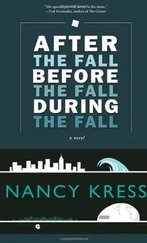1 1 For Thucydides as a fashionable author in the 50s BCE, see Rawson (1985, 22), with Hornblower (1995, 68). For a balancing recognition of the “Unthucydidean” aspects of Sallust’s self-presentation, see Grethlein (2006b).
2 2 For the contemporary impact of the gesso casts from Pompeii, see Dwyer (2010). Pages 96–8 describe photography’s role in the popularization of these images, and the quote, from Werge (1868, 427–8), will be found on pp. 97–8.
3 3 Recent analyses of the scene include Gugel (1970); Batstone (1990, 130–2); Desbordes (1992 = 2006, 269–76); Feldherr (2007); Benferhat (2008); Melchior (2010, 408–13); Grethlein (2013, 301–3).
4 4 Grethlein (2013, 1–26).
5 5 See esp. the suggestive discussions by Feeney (2010, 14–16) and Wilcox (1987, 93–104).
6 6 See Tempest (2017, 213). Beyond the works discussed here, he was also well known as an orator (see Balbo 2013) and even wrote poetry (Plin. Ep. 5.8.5); on his Greek letters, once praised for their style but now generally regarded as fake, see Tempest (2017, 190).
7 7 Flower (2010, 117–34, esp. 131–2).
8 8 See the relevant entries in FRHist for the most up-to-date information on the lives and works of Fannius (12) and Antipater (15).
9 9 Thus Jones (1970) has argued that Cicero couched his Cato as a dialogue, and Tschiedel (1981) considerably plays down the invective in Caesar’s AntiCato (contra Goar 1987, 16–18). See esp. Tschiedel (1981, 13–21) on the “feinsinniges literarisches Spiel” actuated by the exchange of compliments between Cicero and Caesar.
10 10 Cf. Div. 2.3, where he specifically classes the Cato among his philosophical works, with the discussion of Kumaniecki (1970, 185). Of course, there were important precedents for lives arranged “systematically” as opposed to chronologically (the traditional formal classifications of ancient biography). See esp. Momigliano (1971, 88–9), who both connects this tradition with Greek encomia for generals and points to several Greek lives by Nepos as contemporary Roman examples.
11 11 contingebat in eo quod plerisque contra solet, ut maiora omnia re quam fama viderentur: id quod non saepe evenit, ut expectatio cognitione, aures ab oculis vincerentur, Mac. Sat. 6.33.
12 12 Earl (1972, 847–9).
13 13 Sklenář (1998).
14 14 But it was not identical to it. See Broughton (1936, 43–4), who usefully discusses the impact that the postmortem idealization of Cato had on the historiography of the conspiracy. He uses Brutus’ Cato to represent this tradition but also shows that his account of the episode contains procedural errors not present in Sallust.
15 15 This distinction between a view of actions as imitable and repeatable versus as historical events in the past suggests an interesting comparison with Livy’s deployment of exemplarity, as described by Chaplin (2000, see esp. pp. 197–202). There the idea that exemplarity points towards ahistoricity receives an important qualification thanks to Livy’s emphasis on the historical specificity of each evocation of the exemplum. Thus the mode of exemplarity itself comes to bear witness to the distinction between temporality and timelessness. And from the perspective of the individual interpreter of the past—and here the models within the text surely have the potential to model how Livy’s own readership will understand history—exemplarity becomes in and of itself a way of negotiating between the strong sense of distance between the old republic and the present in which behaviors are selected for imitation, and the will to overcome that distance.
16 16 Nep. Cato 3.4; See discussions in Dillery (2009, 99–101); Gotter (2009, 110–112). Sallust mimics this practice in the “Archaeology” (Cat. 6–13), which names only Aeneas and Sulla.
17 17 proinde quasi praetura et consulatus atque alia omnia huiusce modi per se ipsa clara et magnifica sint ac non perinde habeantur, ut eorum qui ea sustinent virtus est “as if praetorships and consulates and all other things of that sort were distinguished and magnificent in and of themselves and not esteemed in proportion to the virtue of those who undertake them” (Jug. 4.8).
18 18 Compare the preface to the Histories (1.11 M), where the moment of Rome’s greatest spatial extent (51 BCE) is contrasted with the period when it possessed the best mores (between the Second and Third Punic Wars).
19 19 Note especially the important argument of Earl (1972) that the form of prologue Sallust chose for both of his monographs would have given particular emphasis to the connection with philosophy by recalling the beginnings of Aristotle’s esoteric works, then first circulating in Rome. Cf. esp. p. 856 on the effects of this allusion.
20 20 Tiffou (1973), for example, argues that Sallust in the monographs “believed in the possibility of reviving the golden age [of Rome’s past]” (p. 581), though he sees the Histories as expressive of a new pessimism.
21 21 I am not suggesting that Brutus’ aim in this treatise was to encourage a retreat into “philosophical” exile. Quite the contrary; Tempest (2017, 56–77) argues that Brutus’ policies in the years before Caesar’s assassination aimed above all at a reconciliation between the dictator and his civil war opponents. Cf. also Sedley’s (1997) analysis of Brutus’ philosophical position: as a Platonist rather than a stoic, Brutus would not simply have claimed that virtus, as the necessary and sufficient cause of true happiness, provided an escape from political circumstances. Instead, his actions as a tyrannicide reveal a Platonic perception that political freedom was itself a good. Therefore, even if within Brutus’ text the picture of Marcellus’ exiled virtutes constitutes a foil to the main argument, or his return ticket to the Caesarean future, it nevertheless shows the topicality of this concern about the place of virtutes in the new state.
22 22 The quantity of scholarship on the prefaces to Sallust’s monographs is in proportion to their distinctiveness. Main issues include whether they have an intrinsic connection to the works that follow or are simply self-standing exercises (for the latter position see esp. Boissier 1903). Efforts have also been made to trace the archaeology of Sallust’s ideas, emphasizing either Platonic (esp. Egermann 1932) or stoic (e.g., Pantzerhielm-Thomas 1936) affiliations. Helpful overviews of the debate include La Penna (1968, 15–67) and Earl (1961, 5–17), who stresses the compatibility of Sallust’s moral philosophy with traditional Roman aristocratic ideals, and Tiffou (1973, 13–35). The latter provides the most extensive analyses of the prologues, and of their interpretative importance for reading the monographs that follow. Like Earl, he would reject the distinction between Greek philosophy and Roman moral practices; in his case based on a rather reductive a priori assertion that “le Romain n’a pas la sens de la transcendance” (p. 284). Also especially notable is the reading of Leeman (1954–1955), who sees both prologues as carefully composed defenses of Sallust’s choice to write history. For more recent treatments, see below, n. 23.
23 23 This opposition within the content of the passage itself mirrors a notable divergence in scholarly approaches to the passage. For, alongside more traditional efforts to explain the content of the prefaces, whether to account for their philosophical affiliations or to analyze their relevance to the work that follows, recent readings of the prefaces tend to stress their sequential impact on their audience, who struggle to reconcile potential contradictions and ambiguities. Noteworthy examples of the latter approach include Batstone (1990); Feeney (1994); Woodman (in Kraus and Woodman 1997, 13–16); and Gunderson (2000). Again, the distinction is between a focus on the preface’s ideational content, timeless and indeed tralatitious, and the inevitably linear way it is experienced within the text.
Читать дальше












